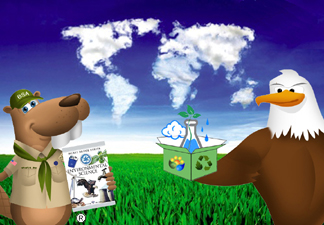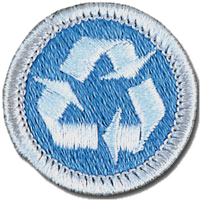Environmental Science


Resources
- Environmental Science Merit Badge Pamphlet
- Environmental Science Merit Badge Class Preparation Page
- Environmental Science Merit Badge Workbook
- Scoutmaster Bucky's Merit Badge Advancement Quick Reference
- Scoutmaster Bucky's Acknowledgement Form
- Scouting America's Environmental Science Counselor Guidelines
- Scouting America's Environmental Science Resources
Related
Environmental Science Requirements
Current Scouts BSA requirements
as of December 6, 2025
as of December 6, 2025
1.
Describe the meaning of environmental science in your own words. Explain
how you think we can use science to understand, conserve, and improve our
environment.
2.
Ecology. Do the following and discuss with your counselor:
a.
Choose an area approved by your counselor and observe (sight, sound,
and smell) its ecosystem over a two-day period.
b.
Make notes about the living, nonliving (e.g. rocks) and formerly living
components. Include information about interactions among the
components, including the food chain, predators, native species, and
invasive species and identify how human activities have affected the
ecosystem.
3.
Air Pollution. Do ONE of the following and discuss with your
counselor:
a.
Learn what Particulate Matter (PM) is, how PM gets into the air, what
the harmful effects of PM are, and what is being done to reduce PM in
the air. Then, perform an experiment to test for particulates that
contribute to air pollution.
b.
Discuss how air pollution and transportation affect each other by
giving at least three examples. Then, compare two modes of
transportation (e.g., gasoline-powered v. electric vehicles,
gasoline-powered car v. bicycle, etc.).
c.
Learn about the Clean Air Act. Make notes on when it was passed, its
environmental goals, what progress has been made and what remains to be
done to achieve the law's goals. Describe the impact, benefits, and
costs of the law as well as what is required to implement and enforce
the law.
4.
Water Pollution. Do ONE of the following and discuss with your
counselor:
a.
Identify where your community sources water, how it is treated, and
disposed. Obtain and review a water quality report from your area.
b.
Identify a local or regional area that experiences periodic flooding
and/or drought. Collect facts on prior event(s) and investigate the
environmental impacts of these extreme events.
c.
Learn about the Clean Water Act. Make notes on when it was passed, its
environmental goals, what progress has been made and what remains to be
done to achieve the law's goals. Describe the impact, benefits, and
costs of the law as well as what is required to implement and enforce
the law.
5.
Land Pollution. Do ONE of the following and discuss with your
counselor:
a.
In an area (yard, park, golf course, farm, etc.) approved by your
counselor, make a list of the pesticides, herbicides, and fertilizers
used and how often they are applied. Identify the benefits of their use
and the environmental impact, including effects on non-target species
(including humans), what happens if the chemicals infiltrate into the
groundwater, and what happens to any runoff of the chemicals.
b.
Learn about the erosion process and identify an example of where
erosion occurs. Determine where the eroded material ends up and how
erosion can be minimized.
c.
Learn about a land pollution incident that led to a site being listed
on Environmental Protection Agency's Superfund National Priority List.
Identify what caused the incident, what the effects were on the
environment, what remediation has been done, and the current condition
of the site.
6.
Rare, Threatened, or Endangered Species. Do ONE of the following and
discuss with your counselor:
a.
Do research on one endangered species found in your state. Learn about
its natural habitat, why it is endangered, what is being done to
preserve it, and how many individual species are left in the wild.
Prepare a 100-word report about the species and include a drawing or
photo. Present your report to your patrol or troop.
b.
Do research on one species that was endangered or threatened but that
has now recovered. Learn about how the species recovered, and what its
new status is. Prepare a 100-word report on the species and include a
drawing or photo. Present your report to your patrol or troop.
c.
With your parent or guardian and counselor's approval, work with a
natural resource professional to identify a completed project that has
been designed to improve the habitat for a threatened or endangered
species in your area. Visit the site and report on what you saw to your
patrol or troop.
7.
Pollution Prevention, Resource Recovery, and Conservation. Do ONE of
the following and discuss with your counselor:
a.
Determine five ways to conserve resources or use resources more
efficiently in your home, school, or camp. Practice at least two of
these methods for at least one week.
b.
Explain Resource Recovery and why it is important to reduce pollution.
Collect samples or take photos of ten items that can demonstrate the
principle of Reduce, Reuse, Recycle. Explain your collection, how these
materials are currently handled, and potential improvements.
c.
Identify five items in your household that will become hazardous waste.
Explain how they should be properly stored, what special care is needed
for disposal, and proper disposal options available in your area.
8.
Pollination. Do ONE of the following and discuss with your counselor:
a.
Investigate pollination and its importance to our environment and
ecosystems. Make a list of five pollinators and the plants that attract
them in your region. Explain the importance of pollinators and what
Scouts can do to support pollinators in their area.
b.
Visit an area with flowering plants during pollination season for an
hour to observe pollination. Record which pollinators are attracted to
which plant. Explain the importance of pollinators and what Scouts can
do to support pollinators in their area.
c.
Learn about the importance of pollination to agriculture, including the
economic costs and benefits. Identify four crop-pollinator pairs.
Explain the relationship of pollinators to agriculture.
9.
Invasive Species. In your community or camp, investigate two
invasive plant or animal species. Learn where the species originated, how
they were transported to this ecosystem, their life history, how they are
spread, how they impact the native ecosystem, and the recommended means to
eradicate or control their spread. Discuss what you learned with your
counselor.
10.
Identify the environmental impact topics that would need to be addressed
for a construction project such as building a house, adding a new building
to your Scout camp, or one you create on your own that is approved by your
counselor. Evaluate the purpose and benefit of the proposed project,
alternatives (including a no-action alternative), and any environmental
consequences. Discuss with your counselor.
11.
Identify three career opportunities that would use skills and knowledge in
the environmental science field. Pick one and research the training,
education, certification requirements, experience, and expenses associated
with entering the field. Research the prospects for employment, starting
salary, advancement opportunities and career goals associated with this
career. Discuss what you learned with your counselor and whether you might
be interested in this career.